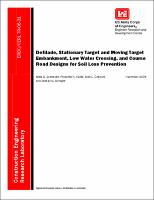Please use this identifier to cite or link to this item:
https://hdl.handle.net/11681/20091Full metadata record
| DC Field | Value | Language |
|---|---|---|
| dc.contributor.author | Svendsen, Niels G. | - |
| dc.contributor.author | Kalita, Prasanta K. | - |
| dc.contributor.author | Gebhart, Dick L. | - |
| dc.contributor.author | Denight, Michael L. | - |
| dc.date.accessioned | 2016-10-12T14:05:11Z | - |
| dc.date.available | 2016-10-12T14:05:11Z | - |
| dc.date.issued | 2006-12 | - |
| dc.identifier.uri | http://hdl.handle.net/11681/20091 | - |
| dc.description | Technical Report | - |
| dc.description.abstract | Abstract: Military training structure designs currently do not employ adequate soil loss prevention technologies that reduce soil loss sufficiently to extend embankment useful life. New range structures must have reduced maintenance requirements and maintain functionality over a longer training interval. Additionally, incorporating sustainability into the range designs should remain a high priority to meet environmental compliance regulations and provide a durable long-lasting structure useful for military training requirements. This report proposes several new range structure designs to begin the iterative process of developing new range edifices that reduce soil loss, control erosion, promote sustainability, and enhance training. The designs for Defilades, Stationary Targets Embankments, Moving Target Embankments, Low Water Crossings, and Course Roads are presented as a demonstration and validation template for installation training areas in temperate climates. These designs are meant to illustrate the use of soil loss prevention measures on range structures. | - |
| dc.publisher | Construction Engineering Research Laboratory (U.S.) | - |
| dc.relation | http://acwc.sdp.sirsi.net/client/en_US/search/asset/1002551 | - |
| dc.title | Defilade, stationary target and moving target embankment, low water crossing, and course road designs for soil loss prevention | - |
| dc.type | Report | en_US |
| Appears in Collections: | Technical Report | |
Files in This Item:
| File | Description | Size | Format | |
|---|---|---|---|---|
| CERL-TR-06-31.pdf | 6.59 MB | Adobe PDF |  View/Open |